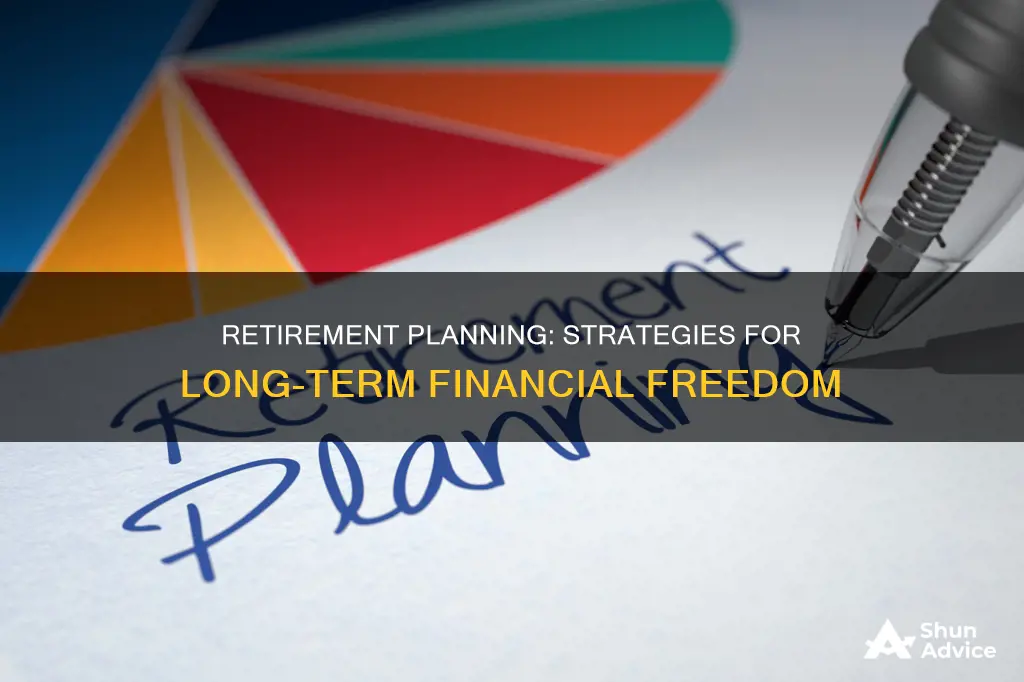
Retirement planning is a multistep process that evolves over time. The earlier you start planning, the more time your money has to grow. However, it's never too late to start retirement planning.
The first step is to define your retirement goals and how long you have to meet them. Next, you need to look at the types of retirement accounts that can help you raise the money to fund your future. As you save that money, you have to invest it to enable it to grow.
Retirement planning should include determining time horizons, estimating expenses, calculating required after-tax returns, assessing risk tolerance, and doing estate planning. It's also important to consider your career, family size, age of retirement, and post-retirement goals.
When it comes to choosing a retirement account, there are several options available, including 401(k)s, IRAs, and annuities. Each option has its own set of benefits and drawbacks, so it's important to carefully consider which one is best suited to your needs.
Finally, determining the right mix of retirement investments depends on how long you have until you need the money and how comfortable you are with risk. Generally, it's recommended to invest aggressively when you're young and then slowly dial back to a more conservative mix of investments as you approach retirement age.
| Characteristics | Values |
|---|---|
| When to start retirement planning | The earlier the better, but it's never too late to start. |
| How much money you need to retire | 70% to 90% of your annual pre-retirement income through savings and Social Security. |
| Prioritise financial goals | Save for retirement while building an emergency fund. |
| Choose the best retirement plan | 401(k) with an employer match, IRA, SIMPLE IRA, SEP IRA, etc. |
| Select retirement investments | Stocks, bonds, mutual funds, ETFs, target date funds, etc. |
What You'll Learn
- Understand the different types of retirement plans available to you, such as 401(k)s, IRAs, and annuities
- Start saving early and take advantage of tax-advantaged accounts to maximize your investments
- Determine your risk tolerance and create a diversified portfolio that aligns with your goals
- Consider seeking professional advice from a financial advisor or planner to ensure your strategy is tailored to your needs
- Regularly review and rebalance your portfolio as life circumstances and market conditions change

Understand the different types of retirement plans available to you, such as 401(k)s, IRAs, and annuities
There are several types of retirement plans available, each with its own unique features, benefits, and tax implications. Here are some of the most common types:
- 401(k) Plans: These are employer-sponsored retirement plans that allow employees to save and invest a portion of their paycheck before taxes. There are two main types: traditional 401(k)s, where contributions are made with pre-tax dollars, reducing taxable income; and Roth 401(k)s, where contributions are made with after-tax dollars, allowing for tax-free withdrawals in retirement. Employers often match employee contributions, and there may be penalties for early withdrawals.
- Individual Retirement Accounts (IRAs): IRAs offer tax-advantaged savings for retirement. The two main types are traditional IRAs, where contributions are made with pre-tax dollars and withdrawals are taxed as ordinary income; and Roth IRAs, where contributions are made with after-tax dollars, and qualified withdrawals are tax-free. IRAs typically have lower contribution limits than 401(k)s.
- Defined Benefit Plans (Pension Plans): These plans provide a fixed, pre-established benefit for employees upon retirement. The benefit is usually calculated based on factors such as age, salary, and length of employment. While pension plans are becoming less common, they offer employees certainty and guaranteed returns.
- Defined Contribution Plans: Unlike defined benefit plans, defined contribution plans do not promise a specific benefit at retirement. Instead, they are based on contributions made by the employee, employer, or both, usually at a fixed rate. Examples include 401(k) plans, 403(b) plans, employee stock ownership plans, and profit-sharing plans.
- Annuities: Annuities are long-term contracts with insurance companies, where individuals make premium payments and receive income during retirement. They offer guaranteed income, tax-deferred growth, and the option of a lump sum or regular income stream. Annuities come in different types, such as fixed, variable, and indexed, to suit varying financial goals and risk tolerances.
- Employee Stock Ownership Plans (ESOPs): ESOPs are retirement plans that allow employees to acquire ownership interest in the company they work for by purchasing company shares or receiving allocated stock. They provide tax-deferred savings and the potential for higher returns, but employees may perceive them as high-risk.
When choosing a retirement plan, it's important to consider factors such as tax advantages, contribution limits, employer matches, investment options, and your financial goals and circumstances. Consulting a financial advisor can help you make an informed decision.
Planning for Retirement Solo: Navigating Your Financial Future Independently
You may want to see also

Start saving early and take advantage of tax-advantaged accounts to maximize your investments
It is important to start saving for retirement as soon as possible. The earlier you start investing for your future, the more your money will be able to compound, and tax advantages can help you amass money even more quickly because you won't have the extra drag from taxes.
There are two main types of investment accounts: taxable and tax-advantaged. Taxable accounts, such as brokerage accounts, offer more flexibility than tax-advantaged accounts. They also have fewer restrictions, but the returns are taxed depending on how long the asset is held. Investments held for longer than a year are subject to long-term capital gains rates of 0%, 15%, or 20%, depending on the investor's tax bracket. Investments held for a year or less are taxed according to the investor's ordinary income tax bracket.
Tax-advantaged accounts, on the other hand, can be tax-deferred or tax-exempt. Tax-deferred accounts, such as traditional IRAs and 401(k) plans, provide upfront tax breaks. Investors pay taxes when they withdraw their money in retirement. Tax-exempt accounts, such as Roth IRAs and Roth 401(k)s, are funded with after-tax dollars, but investments grow tax-free, and qualified withdrawals in retirement are tax-free. These accounts have restrictions and penalties for withdrawals made before the investor reaches retirement age.
There are several other types of tax-advantaged accounts that can be used for retirement savings, including health savings accounts (HSAs) and 529 education savings plans. HSAs offer a triple tax advantage: contributions are made with pre-tax dollars, money grows tax-free, and withdrawals are tax-free if used for qualified healthcare expenses. After age 65, money can be withdrawn from an HSA for any purpose without a penalty, although taxes will be owed on the withdrawal. 529 plans were established as a way to save for education expenses, but they can now be used as a source of funding for a Roth IRA, providing another option for retirement savings.
In addition to taking advantage of tax-advantaged accounts, there are several other strategies that can be used to maximize retirement investments. One key strategy is to contribute enough to take full advantage of any employer match offered by your company. This provides an immediate return on your investment. It is also important to understand asset allocation and to have a properly balanced portfolio that reflects your age and risk tolerance. As you get closer to retirement, your portfolio should become more conservative, with a higher allocation of less risky securities such as bonds. Finally, consider using a robo-advisor or target date fund to automatically rebalance your portfolio as you age and market conditions change.
Social Security: Opting In or Out?
You may want to see also

Determine your risk tolerance and create a diversified portfolio that aligns with your goals
When planning for retirement, it's essential to determine your risk tolerance and create a diversified portfolio that aligns with your goals. Here are some detailed instructions on how to do that:
Determine Your Risk Tolerance:
- Consider your age: Generally, younger investors are seen as more risk-tolerant as they have a longer time horizon. However, don't solely base your risk tolerance on age; other factors, like life expectancy and health, play a role.
- Assess your financial situation: Your net worth and available risk capital impact your risk tolerance. If you have a higher net worth, you can likely tolerate more risk. Additionally, consider your investment goals and priorities. If you're investing for retirement, you may want to take on less risk as you approach retirement age.
- Evaluate your investment experience: If you're new to investing, it's prudent to start with caution. Gain experience and understand the markets before taking on more risk.
Create a Diversified Portfolio:
- Spread your wealth: Diversify across different asset classes, such as stocks, bonds, exchange-traded funds (ETFs), mutual funds, commodities, and real estate. Avoid putting all your eggs in one basket.
- Consider index or bond funds: Investing in securities that track various indexes, such as the S&P 500, can provide diversification at a low cost.
- Regularly review and rebalance: Over time, the performance of your investments will vary, and you may need to rebalance your portfolio to maintain diversification. Review your portfolio at least twice a year.
- Think globally: Don't just focus on domestic investments. Explore international markets, including emerging markets and Europe, to further diversify your portfolio.
- Use target-date funds: These funds automatically adjust your asset allocation as you get closer to your retirement goal, making them a "set it and forget it" option.
- Be cautious of over-diversification: While diversification is essential, too much of it can be counterproductive. Avoid overlapping investments, and focus on holding uncorrelated assets that move in opposite directions.
Invest in Us: The Human Advantage
You may want to see also

Consider seeking professional advice from a financial advisor or planner to ensure your strategy is tailored to your needs
Retirement planning can be a complex and challenging process, and seeking professional advice from a financial advisor or planner can be a wise decision to ensure your strategy is tailored to your unique needs and goals. Here are some reasons why considering a financial advisor for your retirement plan can be beneficial:
- Expert Guidance: Financial advisors are experts in their field and can provide valuable insights and guidance to help you navigate the complex world of retirement planning. They will work with you to understand your current financial situation, including your income, expenses, and goals, and develop a comprehensive plan to ensure you are on track for a comfortable retirement.
- Investment Strategies: Advisors can help you build and manage a well-diversified investment portfolio that aligns with your risk tolerance, time horizon, and retirement goals. They will assist you in choosing the right mix of stocks, bonds, mutual funds, and other investment options to maximize your returns while minimizing risks.
- Tax Efficiency: Retirement planning often involves complex tax considerations. Financial advisors can help you navigate the tax implications of different retirement accounts, such as traditional IRAs, Roth IRAs, 401(k)s, and more. They can advise on tax-efficient strategies, such as tax-deferred growth or tax-free withdrawals, to minimize your tax burden and maximize your after-tax income during retirement.
- Risk Management: A good financial advisor will help you assess and manage risks effectively. They will ensure your retirement plan considers factors such as inflation, market volatility, and longevity risk, adjusting your strategy as needed to protect your finances.
- Personalized Advice: Financial advisors provide personalized advice tailored to your specific circumstances. They will consider your age, health, family situation, and other factors to create a customized retirement plan that meets your short-term and long-term needs.
- Ongoing Support: Retirement planning is not a one-time event; it's an ongoing process. Financial advisors offer ongoing support and guidance, regularly reviewing and adjusting your plan as your life changes. They can help you navigate major life events, such as marriage, the birth of a child, or a career change, ensuring your retirement strategy remains aligned with your evolving needs.
When choosing a financial advisor, it is essential to find one who is trustworthy, qualified, and has your best interests at heart. Look for advisors with relevant certifications, such as CFP (Certified Financial Planner) or CFA (Chartered Financial Analyst), and ensure they adhere to fiduciary standards, putting your interests first. Remember to ask about their fees, services offered, and investment approaches to find the right advisor for your retirement planning journey.
Principal or Investment: Where Should Your Money Go?
You may want to see also

Regularly review and rebalance your portfolio as life circumstances and market conditions change
Regularly reviewing and rebalancing your portfolio is a critical aspect of maintaining a successful investment strategy. It ensures your investments remain aligned with your financial goals, risk tolerance, and market conditions. Here are some key considerations:
- Set a schedule for review: Determine a consistent schedule for reviewing your portfolio, such as quarterly or annually. This ensures you actively monitor your investments and make any necessary adjustments.
- Assess your current holdings: Evaluate the performance of each investment in your portfolio. Identify any underperforming or overperforming assets and consider whether they align with your investment goals.
- Make adjustments: Based on your assessment, adjust your portfolio by selling underperforming investments and reinvesting in more promising areas or rebalancing your asset allocation to match your goals.
- Consider tax implications: When making adjustments, be mindful of the tax implications of selling appreciated assets, as it may result in a substantial tax bill. Consult a tax professional for guidance.
- Stay informed: Keep yourself updated on market trends, economic indicators, and industry developments. This information will help you make more informed decisions and identify potential opportunities or risks for your portfolio.
- Seek professional guidance: Consult a qualified financial advisor who can provide personalized recommendations based on your unique circumstances and goals. They can help you navigate complex investment decisions and ensure your portfolio aligns with your long-term objectives.
By regularly reviewing and rebalancing your portfolio, you can optimize your investment strategy, adapt to changing market conditions, and ensure your investments remain aligned with your financial goals and risk tolerance.
Gas Investment: Worth the Risk?
You may want to see also
Frequently asked questions
The amount of money you need to retire depends on your current income and expenses, and how you think those expenses will change in retirement. The typical advice is to replace 70% to 90% of your annual pre-retirement income through savings and Social Security.
It's recommended to start saving for retirement as early as possible, even if it's a small amount. You can set up automatic transfers from your checking account to your retirement account so you don't forget to save. It's also a good idea to have a separate emergency fund to cover any unexpected costs.
There are several types of retirement accounts available, including 401(k)s, IRAs, and SIMPLE IRAs. The best account for you will depend on your individual circumstances, such as your age, income, and tax bracket. It's important to consider the tax implications and contribution limits of each type of account.
There are various investment options available for retirement savings, including stocks, bonds, mutual funds, and exchange-traded funds (ETFs). It's important to consider your risk tolerance and time horizon when choosing investments. Diversification is key to reducing risk and smoothing out market ups and downs.







